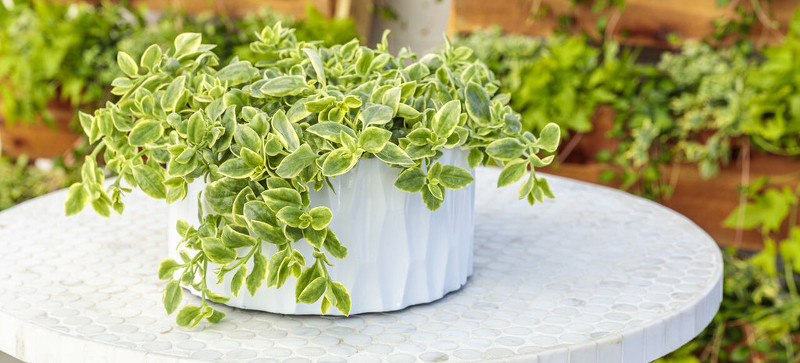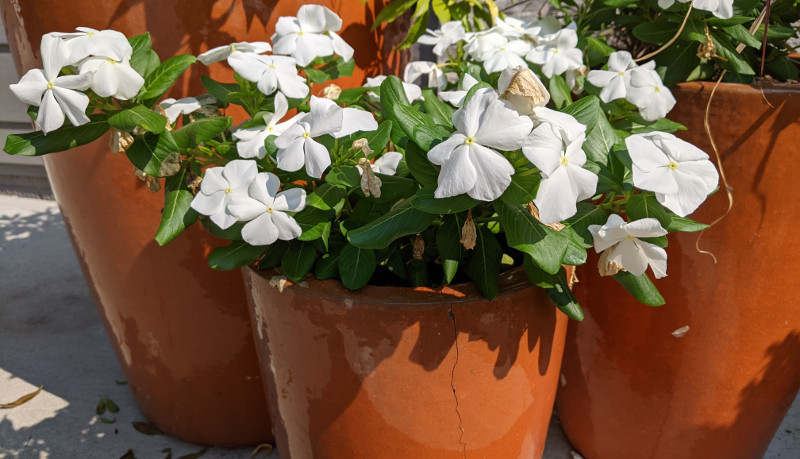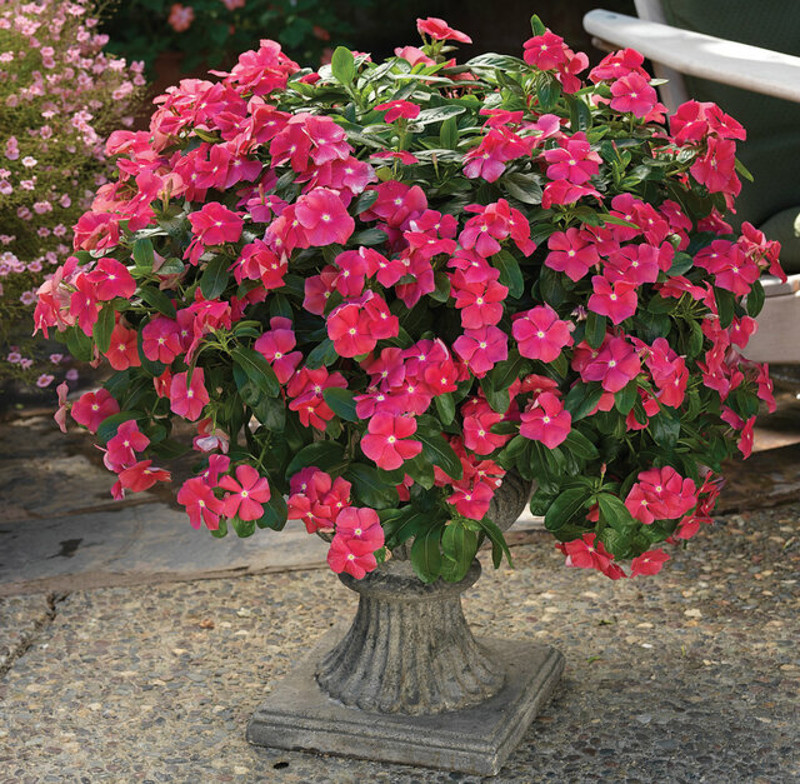Vinca (Catharanthus roseus) is an annual flowering plant often used as a ground cover or bedding plant. Popular for its creeping habit and colorful blooms, Vinca can be successfully grown as a container plant. Planted alone or alongside companion plants, Vinca is perfect for containers, hanging baskets, windowsills, or raised planters. Attracting butterflies, Vinca adds color to decks, porches, patios, and balconies. Be cautious of container location as ingesting all parts of Vinca can be toxic to animals and people.

Planting Vinca in Pots
Vinca is a heat and drought tolerant flower. The plant can struggle with cooler temperatures. It is best to plant Vinca after the threat of frost is complete and when the night time temperatures remain above freezing. For some areas, this could be as late as April or May. Choose a site that will get full to partial sun each day. Catharanthus roseus is very easy to grow in a container.
This fast growing plant will easily grow out of its container in no time. For best results, move the plant to a container one size larger every 6-8 weeks. Do not start out with a too large of a container as this will give the plant too much water which can lead to root rot. Select a resin or plastic container with good drainage holes.
Best Soil For Vinca in Pots
Vinca is a very low maintenance plant that requires little care. Plant the flower in a good quality potting soil that drains well. Adding a little perlite to the soil can help with drainage. Steer clear from garden soil as it will not drain well. It is important that this plant has moist soil, yet does not sit in standing water. Adding rocks to the bottom of the container prior to planting can also help with good drainage.

Caring For Vinca in Planters
Vinca is very easy to grow in containers and is typically maintenance free. Be sure that the container you choose has drainage holes. Water your Vinca when the top two inches of soil feels dry. Place the pot in a location that will get partial to full sun daily. Vinca is a fast growing plant, so you may need to pinch off the plant if it becomes too leggy.
Apply fertilizer every two weeks to promote continued blooming. Container Vincas can be brought indoors as a houseplant for the winter. Place it in an area that is warm and gets a lot of daily sun.
Watering Vinca in Pots
Vinca plants are heat and drought tolerant. This plant likes evenly moist soil. Once established, typically the flowers will need water every other week. Follow the general rule that if the top 2 inches of soil feel dry to the touch, then water the plant. If the Vinca is receiving regular rainfall, then additional water is not needed. Keep in mind that plants in containers tend to dry out a lot faster. Be sure that the pot you choose has drainage holes as this plant does not like wet roots.

Fertilizing Vinca in Pots
Vinca is a low maintenance plant that can grow in even the poorest of soils. This plant does not require fertilizing to survive; however, feeding the plant does have its benefits. You can keep your Vinca blooming all season long with regular applications of an all purpose general fertilizer. Apply fertilizer every few weeks and water well after each application. Follow the packaging guidelines for best results.
Winter Care For Vinca in Pots
Vinca (Catharanthus roseus) is often referred to as “annual vinca” for that exact reason. Unlike Vinca major and Vinca minor which are grown as perennials, Catharanthus roseus is grown as an annual. The plant will die back when the first hard frost hits.
New Vincas will need to be planted in the spring. In fact, older Vinca plants can become unattractive and spindly with less blooms as time goes on. So it may not be worth the time and effort to bring the plants in for the cold weather season if the end result is a less than desirable plant with few blooms the following spring.
Can Vinca Be Grown Indoors
Vinca (Catharanthus roseus) can be successfully grown indoors as a houseplant if given the same growing conditions that it would get outdoors. This heat and drought tolerant plant likes a warm humid climate and full sun for at least 6 hours a day. A windowsill or a sunroom would be a great place for the Vinca to thrive.
Keep the soil evenly moist, watering when the top 2 inches of soil feels dry. Prune the plant as needed to prevent it from becoming too leggy. Pinch off spent blooms to encourage new blooming. Fertilize once a month. Your Vinca may need to be moved into a larger container every 6 to 8 weeks.
 |
Author Chris Link - Published 10-11-2021 |
